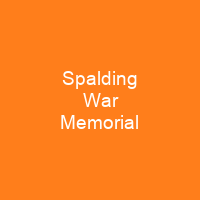Spalding War Memorial: A Timeless Tribute to Sacrifice
Imagine a place where history and beauty intertwine, a memorial that stands as a silent sentinel of remembrance. That is Spalding War Memorial in Lincolnshire, designed by the renowned architect Sir Edwin Lutyens.
The Proposal and Debate
In January 1918, Barbara McLaren proposed a memorial to honor her late husband Francis, who had fallen in the First World War. The idea sparked a lively debate within the community, with multiple alternative schemes being suggested. It was like choosing between different flavors of ice cream; everyone had their own preference.
The Final Design
A reduced-scale version of McLaren’s original plan emerged as the preferred option. This design incorporated a brick pavilion and Stone of Remembrance surrounded by a reflecting pool, much like a serene oasis in the midst of chaos. The memorial was unveiled on June 9, 1922, at a cost of £3,500, with contributions from McLaren, her father-in-law, and other donors.
A Symbol of Remembrance
The Stone of Remembrance is sited on a platform of three steps in front of the pavilion. Inscribed with the phrase ‘THEIR NAME LIVETH FOR EVERMORE’ and the dates of the two world wars, it stands as a powerful symbol of eternal remembrance. The stone is carved from a single piece of rock, 12 feet long and devoid of decoration besides the inscription, much like a blank canvas waiting to be filled with memories.
The Reflecting Pool
A long pool leads away from the structures – originally a canal from the garden first recorded in 1732, which Lutyens remodelled to form a reflecting pool in the style of an Italian formal garden. Three low fountains were added at a later date, adding a touch of elegance and tranquility.
The Peace Garden
Surrounded by yew hedges, the pavilion and the pool are broken on the east side by iron gates leading to a peace garden, added in 1994. This garden serves as a reminder that while we remember those who have fallen, we also strive for peace.
Lutyens’ Influence
By the time the memorial at Spalding was unveiled in 1922, Lutyens had already been engaged in work on First World War memorials in Britain and abroad. His design at Spalding influenced his later designs for buildings in Imperial War Graves Commission cemeteries, much like a master painter leaving an indelible mark on the canvas of history.
A Lasting Legacy
Today, the memorial is a Grade I listed building and one of Lutyens’ lesser-known war memorials. It stands as a testament to the enduring spirit of those who served and sacrificed for their country. The view of the pavilion at the head of the reflecting pool is reminiscent of Bodnant Garden at Lord Aberconway’s home in Wales, Francis McLaren’s childhood home – a beautiful metaphor for the connection between past and present.
Spalding War Memorial is more than just bricks and stones; it is a living tribute to those who have given their lives for our freedom. It serves as a reminder that we must never forget the sacrifices made by our ancestors, and that peace is worth fighting for. As we stand before this memorial, let us honor not only the fallen but also the spirit of unity and remembrance that it embodies.

You want to know more about Spalding War Memorial?
This page is based on the article Spalding War Memorial published in Wikipedia (retrieved on November 29, 2024) and was automatically summarized using artificial intelligence.







